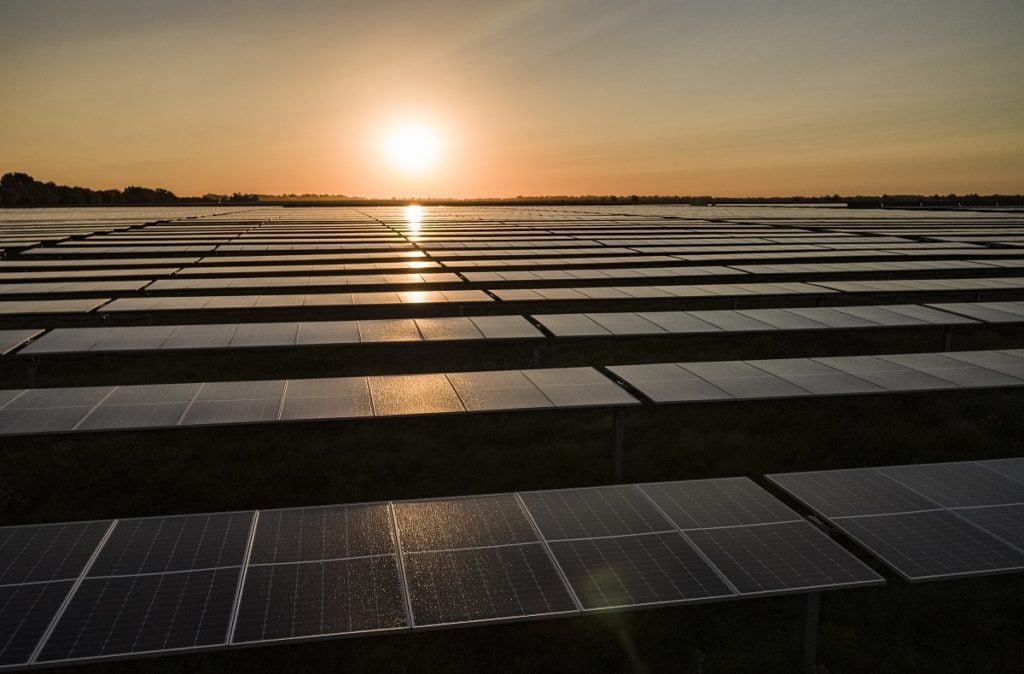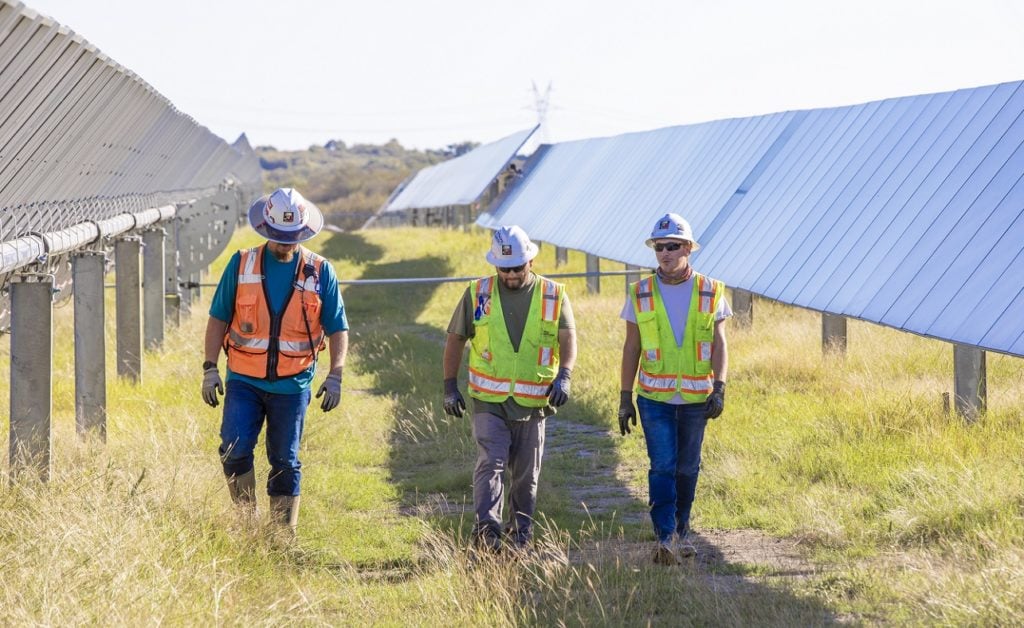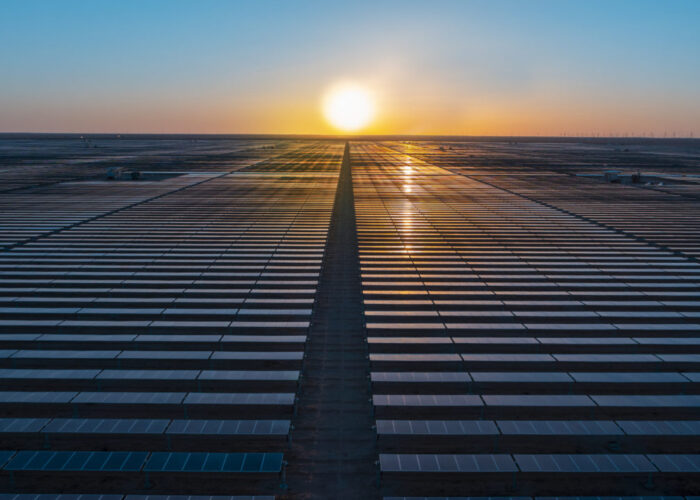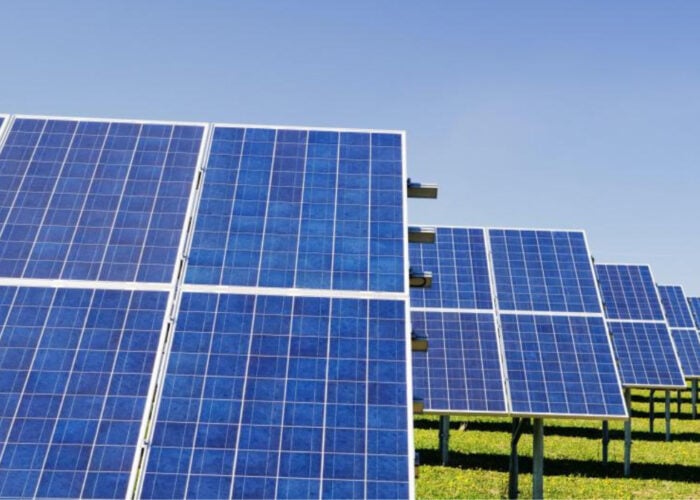
In September 2021 Lightsource bp set itself the target of reaching financial close on 25GW of solar by the end of 2025. Liam Stoker spoke to the developer’s leadership team to discover how it is expanding into new markets, securing financing deals and assembling a workforce capable of reaching that target.
Lightsource bp – the solar developer co-owned, as the name suggests, by energy major bp – is in a race to ramp up its solar deployment. The race isn’t against any perceived challenger or obstacle, but to meet the developer’s own lofty ambition.
Unlock unlimited access for 12 whole months of distinctive global analysis
Photovoltaics International is now included.
- Regular insight and analysis of the industry’s biggest developments
- In-depth interviews with the industry’s leading figures
- Unlimited digital access to the PV Tech Power journal catalogue
- Unlimited digital access to the Photovoltaics International journal catalogue
- Access to more than 1,000 technical papers
- Discounts on Solar Media’s portfolio of events, in-person and virtual
In September 2021, the company drastically increased its previous deployment targets, setting itself the aim of bringing 25GW of solar PV to financial close by 2025. Having in 2018 (the year after bp acquired a 43% stake in the business) set itself the target of bringing 10GW to close by 2023, it constituted quite the uptick in ambition.
Speaking to PV Tech Power, Lightsource bp CEO Nick Boyle says the increased target was set in stone after it became apparent that the initial aim would quickly be outdone, something he described as being “typical Lightsource”. Instead of resetting the 2023 goal, because of the development time necessary for certain projects it made more sense to set a more aggressive target for two years down the line.
But setting that target and announcing it to the market was a dangerous move reputationally, Boyle says, despite the company having the upmost confidence in it being met. “It just constitutes doing more of the same which, yes, means we’ve got to bring on a significant number of additional people. But these are additional people in additional countries to do the same as we’ve historically done, rather than anything new,” he says.
With a new target on the horizon, the developer has since set about placing all of its ducks in a row in terms of financing, development opportunities and the manpower to get the job done.
New horizons
When bp acquired its 43% stake in Lightsource – the company has since increased its stake to 50% – the solar developer had not long since broken out of its home market of the UK and was pursuing opportunities in five markets. That list now stands at 16, and grows every year, Boyle says.
The US, where Lightsource bp is pursuing opportunities from New York to California, constitutes around 40% of the company’s operational activities. Western Europe remains a core market for the firm, while a presence is also held in the solar hotspots of Australia, India and Brazil. This is now being followed up with a concerted move into a number of Asian markets as the company heads further east than it has before. A Southeast Asian hub in Singapore has recently been opened, with eyes on Taiwan, Vietnam and Korea. The company’s first projects in Taiwan are set to be announced in March 2022 which will see the developer complete arrays above fisheries in the country. An additional team on the ground in China is tasked with various support roles, such as equipment QA.
“What we’re not trying to do is move into every single market in parallel. That’s not doable”
Nick Boyle
The key to juggling so many markets at once, Boyle says, is to basically not do them all at once. “What we’re not trying to do is move into every single market in parallel. That’s not doable,” he says. That said, group COO Ann Davies notes that the company will indeed double the number of projects it has in construction this year, with a doubling in the number of deals concluded also set to help increase its activity.
With just under four years to go, Lightsource bp is already in hot pursuit of that 25GW figure. “We’ve got a significant percentage of them [projects] already in the bag,” Boyle says. “But that doesn’t mean that we’re not continuing to look for new greenfield assets, and indeed, continuing to buy early or even middle stage, pre-developed assets.”
Identifying the right markets can, however, be a little trickier, with Lightsource bp looking for the right mix of ample development opportunities, supportive domestic attitudes to solar and a grid that’s conducive to distributed generation.
Rather than having specific policy or subsidies in place, Lightsource bp wants to work with national governments, rather than against them. “There’s no point pushing against someone if there are countries that have a positive attitude towards solar. There are countries where development is more challenging, [and] we would avoid those because of the fact there are countries where those restrictions don’t exist,” Boyle says.
But outside of the political sphere, one of the biggest hurdles remains the grid. “I think the grid is a massive differentiator. In some countries the issue is that the existing grid is under pressure and therefore needs upgrading, but in some newer countries maybe the grid just doesn’t exist. Those challenges in a distributed generation business such as ours are extremely important,” Boyle adds.
Scaling up
This is exacerbated by the scale at which Lightsource bp looks to operate. “Scale is important to us, and if we are going to enter a new market, we want to be leading it and scaling within that market. If all the above allow us to build scale – and it could be within the next couple of years or longer term – those are factors we consider,” Davies says.
Boyle says the “two letters at the end of our name” indicate the value it places on volume. “From our perspective, to go into a country we need to a couple hundred megawatts there, but ultimately that market needs to be gigawatt-plus, otherwise it’s simply not worthwhile for us,” he adds.
That scale has repercussions elsewhere. Davies says Lightsource bp is a more attractive customer for both services and equipment, with the developer forging partnerships with its suppliers that “only become available” at that kind of scale. “And I think that helps us weather some of the storms on the supply chain by working together,” she says.
That much was perhaps evident in November 2021 when Lightsource bp signed a 5.4GW module supply deal with thin film specialist First Solar, a deal which secured ‘Made in America’ modules for its US portfolio – important against the backdrop of heightening trade tensions between the US and China – and, as Davies notes, diversified its module supply away from polysilicon-based modules that have risen so dramatically in price over the past 12 months. The benefits are mutual, however, with both Davies and Boyle stressing the certainty the contract gives First Solar in its capacity roadmap.
Supply chain volatility has dented project economics almost universally in the past 12 months. A 20%+ increase in module costs has triggered project pushbacks, but not, in the case of Lightsource bp, any firm decision on whether or not a market works for them. “That’s more deciding when we go, rather than necessarily if we go,” Boyle says.
But an unavoidable consequence of delivering gigawatts of solar in such a constrained timeframe is the need for financing to ramp up in tandem. For that target to be achievable, Lightsource bp would have to mobilise financing unlike anything the developer had done previously.
“If we are going to enter a new market, we want to be leading it and scaling within that market”
Ann Davies
Upping the game, upping the volume
“We needed to up the game and the volume, and that is exactly what that represents,” Boyle says, when drawn onto conversation around the US$1.8 billion credit facility it closed with 10 major banks and financing institutions in September last year. High street banks such as Natwest and Santander were joined by major financial services firms such as Wells Fargo and Mitsui Sumitomo. The company cast its financing net farther than it had done previously, too, bringing in financiers it had yet to work with.
In truth, Lightsource bp could have struck a similarly-scaled financing package with a smaller number of banks, and that would of course had been easier to conclude. But the strategic importance of forging relationships with larger banks now moving into the renewables space – and doing so in volume – was not lost on Lightsource bp. The company now fully intends to go back to these financiers in the not-too-distant future. “By illustrating, here’s what we’ve done in a safe and controlled environment, we’re able to then say to them: let’s go again and increase the funding,” Boyle says.
With new names entering solar and broader renewables financing, Boyle says conversations with potential lenders are easier than ever before even despite the aforementioned supply chain volatility and increased scale at which the PV industry operates at. “After pressure from shareholders and boards to invest in renewables – solar is right in that sweet spot,” Boyle says, adding: “The low carbon economy represents a massive potential area of growth for banks.”
It’s a symbiotic relationship, of course. Without that scale of lending, Lightsource bp could simply not achieve what it needs to.
Fortunately, in power purchase agreements the solar industry has an instrument that banks are now entirely au fait with. Prior to bp’s involvement in what was then Lightsource, the developer was a champion of corporate PPAs and, perhaps, ahead of its time. Uptake in 2015 and 2016 was low initially, but now the industry has demonstrable success and a replicable template, the market is taking off. “The ability to say ‘here’s one we made earlier’ is hugely positive. Back in 2015 or 2016, it was a short list of companies looking to sell PPAs and an even shorter list of companies looking to buy,” Boyle says.
PPAs are also music to the ears of investors, offering bankability and certainty to revenue streams that, in an environment dogged by power price volatility, can calm the pulse of even the most risk averse financier. Davies says matching the tenure of financing to the tenure of the PPA creates a mechanism in which the bank is essentially lending money for a period of time when they know exactly how much the project is going to be generating, changing the financing entirely.
There is, however, potential upside in leaving some revenue streams open to that volatility though, with merchant-based revenues enjoying periods of spiking power prices across Europe in particular. In Europe, Lightsource bp is aiming for a contracted versus merchant revenue split of 70:30, a ratio the company says allows some exposure to that potential upside, but ensure revenue stability at the same time.
With financing in the bag and a long list of projects to be worked on, Lightsource bp is now casting its eyes internally and readying itself for what looks certain to be a frenetic three years.

Building the machine
Establishing a target, identifying the right markets and projects and arranging the requisite financing is, of course, a considerable way towards achieving your business aims. But without the necessary people to make it happen, those projects will only ever exist on paper. It’s for this reason that Lightsource BP committed to creating some 500 new permanent roles at the business when the 25GW target was set in stone.
Around 400 vacancies are to be filled this year, Boyle says, spread across various job functions. Engineers, financiers, developers, HR professionals and those who work in communications have either joined the business already or will join in the months ahead as Lightsource bp looks to make another leap in scale.
Boyle and Davies both state that the recruitment across the company into different job functions is about “building the machine” that supports the entire business in its aim. “We need to build the machine where the machine is one that can develop across 16 countries safely, sustainably and with quality engineering. We need to get that right,” Boyle says.
But is that easier said than done? As this volume of PV Tech Power illustrates (p.15), there are concerns about a looming skills gap in solar PV. Boyle says that while indeed Lightsource bp is attracting a quality of individuals that is “going through the roof”, it needs more. “There’s never been a more exciting time to be in energy, and I don’t think it’s ever been more challenging,” he adds.
Recruiting in more technical areas is especially challenging, Davies says, compounding the general sense within some solar circles that there just aren’t enough skilled engineers to go around. This becomes even more prevalent in high voltage areas, where competition for the labour force is especially fierce.
“It forces us to become attractive employer, look in different pools and think creatively about the type of experience and individual we need,” Davies says, highlighting one recent apprentice in particular that has joined from a previous role as a musical director, but is tapping into a digital skillset to work on digitalising Lightsource bp’s solar assets.
There’s something of a saying in UK solar circles that Lightsource bp – or simply Lightsource, as it was formerly known – has contributed towards the careers of so many PV professionals in the country that it’d be more appropriately referred to as the University of Lightsource. Boyle compounds this by noting that during a recent round of discussions with six companies in the space, each had an ex-Lightsource staffer near the top of the organisation.
“The unfortunate thing about having the University of Lightsource is that we had to pay to train them and now someone else is milking the benefit,” Boyle says, stressing how his company’s position in the market and talent of those it recruits and brings through makes it a target. “As the number of new players increases, obviously they’re going to go to Lightsource to potentially attract those players.”
The importance is therefore on maintaining talent, and not just attracting it. Something as simple as paying individuals appropriately and ensuring the environment is right in terms of career path can go a long way, Boyle says. “We treat them with respect and make sure that we create the right environment to make sure they’re thriving in their careers. It’s the right thing to do because it means there’s a greater stickiness to us as an employer,” Boyle says.
Recent research published by BloombergNEF revealed that in 2021, Lightsource bp topped the list of global buyers of development assets. Enel was second, with a multi-gigawatt gap separating the two. “It’s not only that we were the biggest, which is amazing, but it’s the margin by which we were the largest… it’s really great to be up there with some of the market leaders,” Boyle says. With three years to go and just over 20GW to close on to reach its stated aim, Lightsource bp is primed to lead the charge on solar PV throughout this decade.







